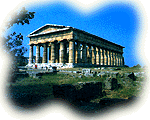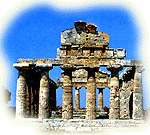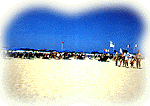 |

|
| GENERAL INFORMATION |
|
In VII century B.C. near the sea, on the Gulf of Salerno, was founded by the Achaei the town of Poseidonia, which still now forms the most remarkable and evocative architectural unit of the Magna Graecia with its town-walls (4.750 m.) three Doric Temples (so called: Basilica, Tempio di Nettuno, Tempio di Cerere) and with other little temples of minor importance. In IV century B.C. the Greek Poseidonia became the Lucan Paistom and after a century, with the arrival of the Romans, Paestum. In III century A.D. the Christian faith asserted its authority, as documents a stern paleochristian Basilica (beginning of V century). The National Museum contains works of particular historical and artistic importance and is enriched with continuous excavations (the fresco "The tomb of the diver", a very rare example of Greek painting in existence, was found in 1968). In this land the Greek Ginius found all the possibilities to express itself in the most accomplished and creative work of the human mind: the sun shining, in every season, fruitful panoramic hills, refreshing summer breezes, everything in the typical Mediterranean light. This wonderful scenery is still largely intact, for you, tourist, who come from everywhere; you will find here a mild climate in every season, a very clean sea, no poisons of the industrial civilization, a beach that still let you be in a restful loneliness on a soft sandcarpet which extends for 15 km. In Paestum, life is movement without any noises. You will find a succession of hotels, touristic, villages and campings with every comfort, along the luxuriant sea-pinewod; you will also see, somewhere, the buffalo which pastures quietly in its natural and authentically nineteenth-century milieu.
|
||




 AAST
AAST